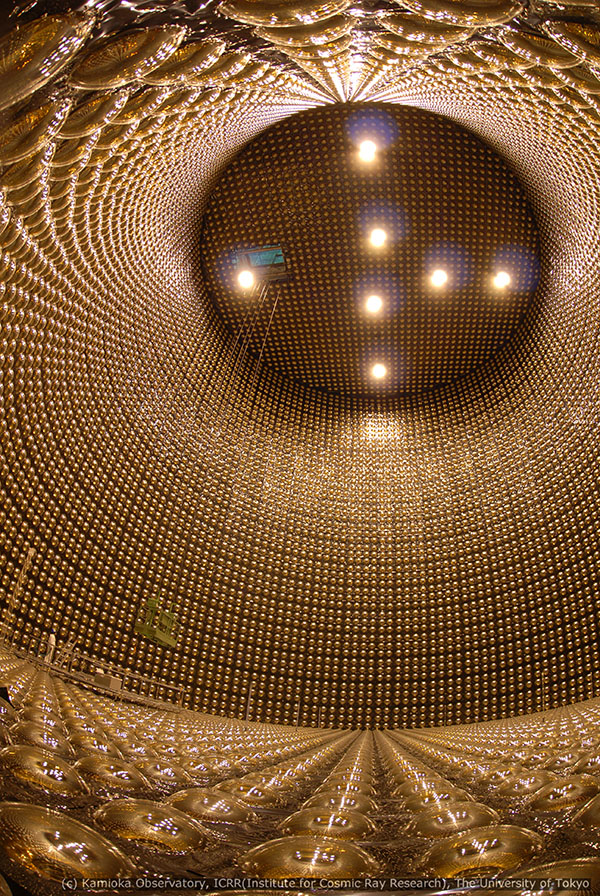International Collaboration Confirms New Type of Neutrino Oscillation
Observation of transformation of muon neutrino to electron neutrino is first step for experiment to explore matter-antimatter mystery

A team of international scientists, including several at the University of Rochester, has announced the first definitive observation of the transformation of muon neutrinos to electron neutrinos – a type of neutrino oscillation that had not previously been observed. The researchers reported the new results this week at the European Physical Society meeting in Stockholm.
The new finding is exciting to scientists because it could help explore a fundamental question of science – why is the universe made up almost exclusively of matter, when matter and antimatter were created in equal amounts in the Big Bang? Somehow this balance changed over time to a dominance of matter. The mechanism for this to occur could lie in a process called charge-parity (CP) violation.
The experiment shows that researchers can now accurately observe the type of neutrino oscillation that will need to be studied in detail in future experiments aiming to measure CP violation, explained Steven Manly, professor of physics at the University of Rochester and part of the collaboration. Until recently it was an open question as to whether or not it would be feasible to explore CP violation in neutrinos. CP violation has only been observed in another type of particle, quarks (for which Nobel Prizes were awarded in 1980 and 2008), never in neutrinos. The observed type of neutrino oscillation is sensitive to CP violation and the T2K experiment will try to observe this process in neutrinos over coming years. It could be that the asymmetry between matter and antimatter lies with neutrinos, which is why observing CP violation in neutrinos would be exciting, Manly added.
"Our goal now is to push to better understand the errors in the measurements and continue to collect sufficient data to explore this possible CP violation." The T2K experiment, based in Tokai, Japan, expects to collect 10 times more data in the near future, including data with an antineutrino beam.
Professor Kevin McFarland, a postdoc and three graduate students are also part of the Rochester team that has been collaborating on this work. Manly explained that neutrinos are notoriously difficult to study, and the oscillation the researchers seek can be mimicked by other processes. For that reason, the Rochester group has focused on understanding these other processes to ensure that what is measured is really the neutrino oscillation they have sought.
In 2011, the collaboration announced the first hints of this process. The researchers have now gathered 3.5 times more data and this transformation is firmly established. The probability that random statistical fluctuations alone would produce the observed excess of electron neutrinos is less than one in a trillion.
In the T2K experiment, a muon neutrino beam is produced in the Japan Proton Accelerator Research Complex, called J-PARC, located in Tokai village, Ibaraki Prefecture, on the east coast of Japan. The neutrino beam is monitored by a detector complex in Tokai and aimed at the gigantic Super-Kamiokande underground detector in Kamioka, near the west coast of Japan, 295 kilometers (185 miles) away from Tokai. An analysis of the data from the Super- Kamiokande detector associated with the neutrino beam time from J-PARC reveals that there are more electron neutrinos (a total of 28 events) than would be expected (4.6 events) without this new process.
The T2K experiment was constructed and is operated by an international collaboration. The current T2K collaboration consists of over 400 physicists from 59 institutions in 11 countries. The U.S. T2K collaborating team consists of approximately 70 members and is funded by the U.S. Department of Energy, Office of Science. The U.S. groups have built super-conducting corrector magnets, proton beam monitor electronics, the second neutrino horn and a GPS time synchronization system for the T2K neutrino beamline; and a pi-zero detector and a side muon range detector (partial detector) in the T2K near detector complex. They are also part of the team that built, upgraded and operates the Super-Kamiokande detector.
In its press release the T2K collaboration also acknowledges the effort by the J-PARC staff members and management to "deliver high quality beam to T2K after the devastating March 2011 earthquake in eastern Japan, which caused severe damage to the accelerator complex at J- PARC, and abruptly discontinued the data-taking run of the T2K experiment."
More detailed information on this announcement, including images, T2K experiment and T2K collaboration, can be found from the T2K public webpage: http://t2k-experiment.org.
